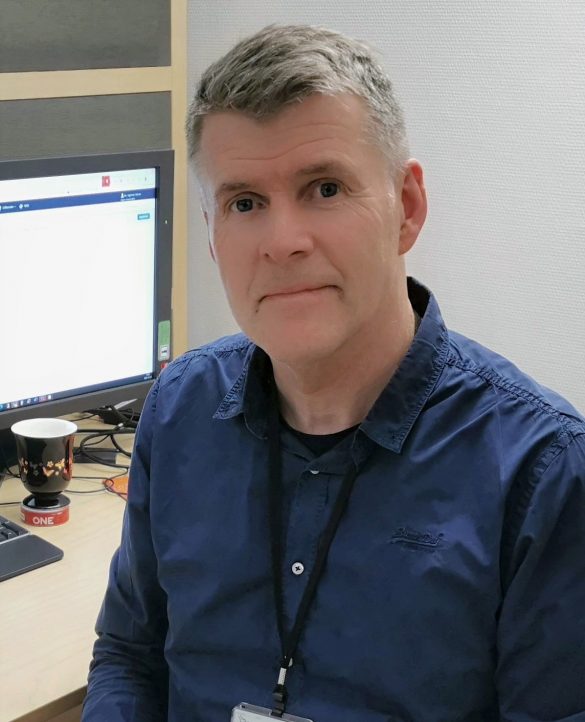Sectra Analytics comprises two services that provide statistics that create value from Sectra PACS and RIS: Sectra Business Analytics and Sectra Workflow Analytics. The difference between the services is that Sectra Business Analytics displays historical data and trends up until midnight of the previous day, while Sectra Workflow Analytics retrieves data in real time. These services lay the foundation for truly information-driven healthcare and for choosing the right efficiency measures in diagnostic imaging operations.
What does a diagnostic imaging department spend its time on? What are the busiest times for staff, and what drives the workload at those times? Gaining a true understanding—and implementing the right measures—requires both access to accurate data and time for follow-up. More and more Swedish regions and healthcare providers are now beginning to implement information-driven healthcare. Two regions taking the lead are Halland and Västernorrland, which were pilot customers of Sectra Business Analytics when it came to accessing statistics that create value in 2022.
We interviewed Ingemar Moran, Region Halland IT object leader, and Peter Dewindt, Region Västernorrland healthcare controller, who were responsible for statistical sampling during the pilot project. In this article, they discuss the importance of data follow-up, how their work on statistical sampling and data insight has changed, and their visions for the future.
I feel more confident about our statistics management today, since I have greater control over how I access data, and the people requesting statistics in the organization put more trust in me […] I also think working with this is fun—time flies when I'm using Sectra Business Analytics
Data insight in the diagnostic imaging process—what’s it for?

Peter Dewindt, Region Västernorrland healthcare controller
“The radiology department is viewed as a service function in healthcare, and both lead times and volumes are critical to our follow-up, not least in dialogue with the referring units,” Peter begins. “I’m convinced that we should strive for care that is driven by facts rather than perceptions. We’ve been hearing for a long time that operations are close to buckling under, that certain types of examinations are being performed too often, and that the staff don’t have time to do it all. With transparency and actual numbers available, we can see that yes, certain examinations are performed a lot—but only sometimes. These numbers are helpful, not only for management to have access to, but also for creating the right conditions for the operation. It becomes possible to show specifically what’s not working, rather than just referring to someone’s perception that this is the case.”
In May 2021, Region Västernorrland deployed a region-wide cloud service from Sectra to its radiology and clinical physiology operations in order to streamline reviews and simplify the management of examinations throughout the entire region. This also laid the foundation for performing data follow-up more flexibly and in close consultation with the operation.
Peter continues: “In the past, we needed to order explicit data output lists from the vendors we had at the time. Each list cost money, and we didn’t have the ability to make changes ourselves, which is obviously a major restriction on our data access. It was also difficult to perform quality assurance and completely rely on the data outputs, since we didn’t have access to the underlying parameters. The IT administrator was the one who managed these lists and shared the data upon request. Few people outside senior management saw the information—it was used primarily as a basis for charging referring physicians, not for creating transparency in the operation as a whole.”
We have people in the region whose job involves business intelligence and data mining, which they’re great at. But if you don't know the radiology workflow, it's easy to get onto the wrong track. And the people who know the radiology workflow may not have the knowledge to dig into data warehouse environments. This product actually builds a bridge between them. You don't need to be a professional database engineer to use Sectra Analytics.
Ingemar agrees with Peter, and emphasizes the importance of actually being able to see hard numbers, not just going on a hunch. “Smoothly functioning data follow-up makes it

Ingemar Moran, Region Halland IT object leader
possible to plan production by seeing trends, such as an increase in the number of referrals and what types of examinations the referring physician wants to have performed. For example, do we have sufficient CT and MR capacity? There is a long lead time for increasing this capacity, so it is unbelievably important to be able to work proactively based on data insights,” he adds.
Ingemar goes on to explain that in the past it was difficult for them to get an overview of all of the radiology units in Halland as a region because of the different IT systems and work methods used at different hospitals. “It’s been difficult for us to achieve data insights. It was difficult to find data subsets that were the same across the region, and therefore it wasn’t possible to compare the numbers. In addition, our previous tools required the creation of a new template every time you wanted a new batch of output. It was an extremely cumbersome process, and it was impossible to refine a data search. We’ve even gone through the actual production system in order to search for data manually.”
In the past, multiple different system supports were used for radiology at different hospitals in Region Halland, but in 2020 they also introduced Sectra PACS and RIS as the shared IT service for radiology. Regional access to images and information has made it possible to obtain a holistic view of each patient as well as to optimize resource use in the region and—as was the case for Region Västernorrland—to increase transparency in the operation in order to answer the question What are we actually doing?
Data follow-up with Sectra Business Analytics—pilot project results
Both regions were viewed as suitable pilot customers for Sectra Business Analytics in connection with the implementation of new IT systems for diagnostic imaging, not least due to the strong drive and interest the regions showed in using data follow-up more actively. The pilot project has entailed a close partnership with Sectra and has focused on teaching users how to understand the data, not just how to use ready-made templates. Both Region Halland and Region Västernorrland have contributed extremely valuable input for the design of the service, especially concerning RIS data.
“Previously, department managers were essentially the only ones to request statistics—but there weren’t many requests, since everyone knew that it wasn’t possible to obtain reliable numbers and you needed to make your request unbelievably detailed and completely accurate at the same time. As I mentioned, every refinement of the request meant a completely new data output template. There was limited access to data, and it was for a limited target group,” Ingemar continues. “Of course, demand is growing now that we have Sectra Business Analytics, and the organization is aware that we can retrieve accurate statistics in an easier and more flexible way. It’s not just department managers who are requesting data now, but also management teams, area managers and administrative managers. Having a flexible tool where you can continually refine your searches makes the lead time from idea to request to a finished report extremely short, which is an unbelievable difference from the past.”
The physicians have started getting more involved, more and more physicians are requesting statistics in order to better understand how they work and to provide input for improving work methods and processes. Even section managers showed a higher level of interest once they realized the data insights give them evidence to use when discussing how to improve conditions with the management team.
Ingemar goes on to describe how they made interesting ancillary discoveries that have helped them improve their work processes in the course of the pilot project with Sectra Business Analytics. “For example, we could see that SCPs (standardized care pathways) were not documented as they were supposed to be, which meant that filtering didn’t work for us when we were running reports. It was Sectra Business Analytics that detected the problem, which we naturally followed up and addressed. Another problem we identified was the variation in how the start and end of examinations were treated. It turned out that a significant share of in-depth examinations took less than a minute, which was due to how the start and stop functions were used in RIS. If the operation then says, ‘Our workload is too high, we don’t have time for everything,’ it’s not possible to follow up on this. It’s important for the start and end of examinations to follow established procedures.”
Peter also explains that the target group of statistics stakeholders in his region has become broader since Sectra Business Analytics was introduced. “The physicians have started getting more involved, more and more physicians are requesting statistics in order to better understand how they work and to provide input for improving work methods and processes. Even section managers showed a higher level of interest once they realized the data insights give them evidence to use when discussing how to improve conditions with the management team. More people have understood that data outputs aren’t just for the management team, but we have some way to go to increase demand from operations—having this type of data insights available is still a new thing.”
As an example of new use cases, Peter mentions following up on how much is sent for external review in order to keep an eye on volumes and lead times, volumes in general and in relation to time, as well as dialogues with referrers. “It’s been an extremely useful tool in these contexts, both to follow up lead times and volumes, but also to enable a good feedback loop.”
When Peter is asked what it’s like for him to do data follow-up today compared with in the past, it’s hard for him to contain his enthusiasm. “I feel more confident about our statistics management today, since I have greater control over my access to data and the people requesting statistics in the organization put more trust in me. They know that they can get answers to their questions now. I also think working with this is fun—time flies when I’m using Sectra Business Analytics. What I did in the past was to press a button to produce a pre-configured report. Now I am actually the one to decide what I exclude and include in the data output. The tool is extremely flexible and dynamic: I can dig in every direction. It makes me feel more motivated and provides a much broader perspective on things, which we didn’t have before. I wish I could use it even more,” he says and laughs.
The system will be able to show the problem, but not to solve the problem.
Challenges and visions for the future
Today, Peter, who previously worked as a radiology nurse and business developer, serves as healthcare controller, a role that is relatively new at Region Västernorrland, and Peter believes that this role is not found in every region. He sees a need to create a distinct recipient organization in order to ensure that data is followed up and that there is also a link to the operation in order to create value. “As I see it, the big challenge is to get the entire operation on board. Having a tool gets us as far as creating information from data. But for the information to create change, it has to have buy-in in the operation. I can produce a tremendous amount of material now, but if operations management doesn’t actually use it then it doesn’t create any value.”
Peter’s vision and hope for the future is to truly work on a fact-based or information-driven basis and to get the operation fully on board. He also mentions that he would really like to capture additional data elements in order to gain an understanding of production, for example of costs in the production context. “That information would create value,” he concludes.
Real-time data is the next step for Ingemar and Region Halland. Today, they have data that is updated daily with statistics from up until midnight of the previous day, and Ingemar is extremely eager to learn what the operation could do with real-time data. “Putting real-time data into an operational context is very new and exciting—there are definitely things we’d like to look at. The concept is brilliant: to be able to see how the radiology department is doing right now, today. I barely dared to imagine that having this type of insight would be possible. It’s almost surreal.”
About Region Halland
Region Halland includes the hospitals in Halmstad, Varberg and Kungsbacka as well as a number of district health centers, which are collectively responsible for providing healthcare services to the region’s over 340,000 inhabitants. Sectra has been a supplier of the region in the area of mammography since 2012 and radiology since 2020.
About Region Västernorrland
Region Västernorrland includes the hospitals in Sundsvall, Örnsköldsvik and Sollefteå as well as a number of district health centers, which are collectively responsible for providing healthcare services to the region’s approximately 245,000 inhabitants. Sectra has been a supplier of the region in the area of mammography since 2012, digital pathology since 2017, and radiology and clinical physics since 2021.
Featured products & services
Related cases





